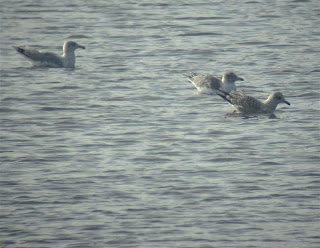The 17th November produced some decent sightings at Holmethorpe SPs with a
BRENT GOOSE briefly in the morning and a female
Mandarin hiding up in the bushes by the bank at Spynes Mere, A
Shelduck also flew in at Spynes Mere. In the afternoon, local birder Jerry found the
FIRECREST in Mercers Country Park car park, with Phil Boswell finding it again in the same area the following day.
Sibelco, the mineral extraction company that own most of the local pits, have been hedge-cutting at Spynes Mere and Mercers West, and have done an excellent job, making viewing these areas much easier now.


We had to wait until the 22nd for the next good bird, an adult
MEDITERRANEAN GULL on Water Colour Lagoon 1. Gordon found this bird and I joined him to photograph it. It was a surprisingly small bird compared to other Med Gulls I have seen.

On the morning of the 23rd I found the
FIRECREST in Mercers CP car park and it showed reasonably well for some time but, frustratingly, never kept still enough to photograph it.
The following day, Gordon picked out an adult
YELLOW-LEGGED GULL amongst the gull roost on Chilmead Farm and, on the 25th, I counted 46
Rooks at the same site – not usually a numerous bird in the recording area at Holmethorpe.
Gordon found the
FIRECREST again near the car park at Mercers CP on the 26th and Ian managed to locate it there on the 27th.
Lapwing numbers had been slowly increasing during this period and by now were up to about 600 birds at Spynes Mere and Mercers West Pit.
The 28th produced two
GOLDEN PLOVERS over Mercers West Pit and a
Water Rail at The Moors and, on the 29th, Gordon relocated the adult
YELLOW-LEGGED GULL, first at Chilmead Farm and later at Mercers Lake, and he found it again the following day at Chilmead Farm.
On the 2nd December, I found the
YELLOW-LEGGED GULL roosting at Chilmead Farm but it was quiet at our local patch until the 7th when Simon Elson noted a
Little Egret at The Moors NR and Gordon found a
mystery duck with the Teal at Spynes Mere. Paul managed to get photos of it late in the afternoon and there were various suggestions to its identification mainly centred around aberrant-plumaged or hybrid Teal, juvenile Baikal Teal and first-winter or eclipse male Garganey – it would be some time before we eventually identified it for certain.


Gordon saw this duck again at Spynes Mere on the 10th and also had an immature
Peregrine fly over.
On the 11th, Ian found a
Little Egret at The Moors and the following day Gordon located the unidentified duck again at Spynes Mere. I joined him and managed to get more photos of it. This time, all the orangey tones on this bird seemed to have disappeared and we now believe that either the low sun, when the bird had previously been seen, had contributed to the apparent colouration, or the bird had advanced in its moult. It now looked likely to be a first-winter or female
GARGANEY. This was later confirmed to be the case.


Gordon located the same bird again on the afternoon of the 13th and we are now hoping that it will extend its stay in the area. Winter records of Garganey in the UK are never numerous.
Our resident
Little Owls have been showing well on sunny days throughout this period and it seems that there are at least three birds in the area.

So far this year, 141 species have been noted at Holmethorpe, only two behind the total for 2010.
Graham

















































